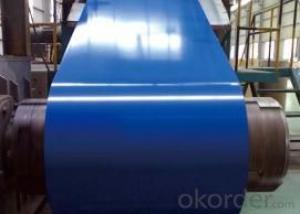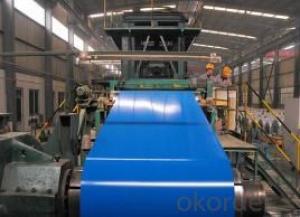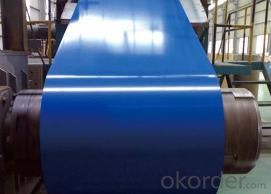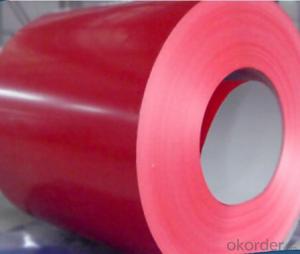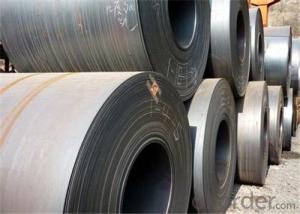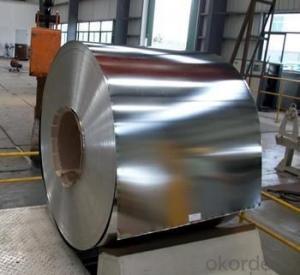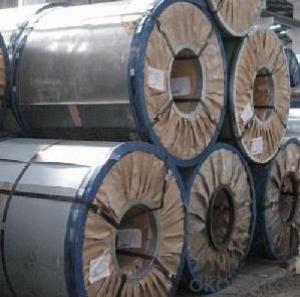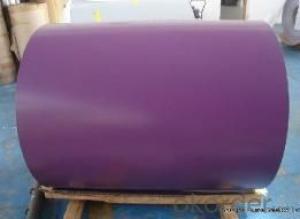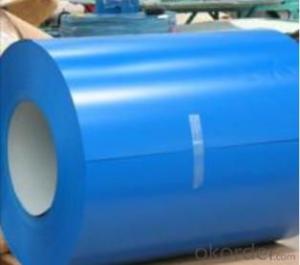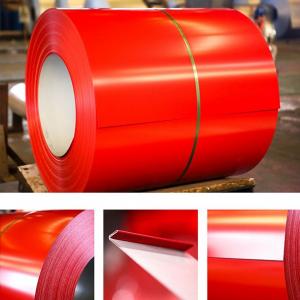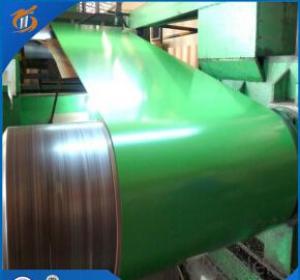Color Coated Alu-zinc Steel Coil PPGP for Construction
- Loading Port:
- Shanghai
- Payment Terms:
- TT OR LC
- Min Order Qty:
- 20 m.t.
- Supply Capability:
- 10000 m.t./month
OKorder Service Pledge
OKorder Financial Service
You Might Also Like
| Standard: | AISI,ASTM,BS,DIN,GB,JIS | Grade: | SGCC,SGCD1,SGCD2.SGCD3,SGC340, | Thickness: | 0.17-2.0mm |
| Place of Origin: | China (Mainland) | Brand Name: | Model Number: | SGCC,SGCD1,SGCD2.SGCD3,SGC340, | |
| Type: | Steel Coil | Technique: | Cold Rolled | Surface Treatment: | Coated |
| Application: | widely | Special Use: | High-strength Steel Plate | Width: | 600-1250mm |
| Length: | coil |
Packaging & Delivery
| Packaging Detail: | standard sea-worthy packaging or as buyers' requirement. |
| Delivery Detail: | Within 20-30 days after we receive depoist or L/C at sight |
color coated steel coil
Product Description
Company | CNBM |
Product | color coated steel coil |
Port | Shang Hai China |
Thickness | 0.17-2.0mm |
Width | 600-1250mm |
Material Grade | SGCC,SGCH,SGCD1-SGCD3,DX51D |
Technique | cold rolled |
Standard | ASTM,GB ,AISI,JIS,EN |
Test | With Hydraulic Testing, Eddy Current , Infrared Test |
Application | Widely used for roofs, outer walls, ovens, explosive-proof steel, electrically controlled cabinets,galvanized tube/pipe, ceiling channel, building material |
Surface | coated |
Package | standard sea-worthy packaging or as buyers' requirement. |
MOQ | 20 tons |
Payment | L/C,T/T |
Delivery time | According to The Specifications And the Quantities,Time Begin When We confirm the Date of the Earnest or L/C. |
- Q: What are the different types of steel coil processing equipment?
- In the manufacturing industry, various types of steel coil processing equipment are utilized. These equipment are specifically designed to handle and process steel coils in different ways, enabling efficient and precise production. Some commonly used steel coil processing equipment are as follows: 1. Decoilers: These machines are employed to unwind steel coils and feed them into the processing line. Equipped with motorized systems, they ensure a steady supply of material by controlling the unwinding process. 2. Straighteners: The purpose of straighteners is to flatten and straighten steel coils that may have become distorted during the coiling process. By utilizing a series of rollers, they eliminate any bends or waves, guaranteeing a smooth and consistent feed to the next processing stage. 3. Slitters: Slitters are responsible for cutting steel coils into narrower strips, allowing the production of various widths of steel sheets or strips. They consist of multiple sets of adjustable circular blades used to achieve the desired width. 4. Levelers: Levelers are utilized to correct any surface imperfections in steel coils, such as wavy or undulating surfaces. By means of a series of rollers, they apply pressure and reshape the material, resulting in a flat and uniform surface. 5. Shears: Shears are used to precisely cut steel coils into specific lengths. They can be either hydraulic or mechanical and are designed to provide clean and accurate cuts, ensuring the desired dimensions are achieved. 6. Recoilers: Recoilers are essential for rewinding processed steel coils back into tightly wound coils. They can be either motorized or manual and are crucial for storage and transportation purposes. 7. Edge trimmers: These machines are employed to remove any excess material from the edges of steel coils. By ensuring a clean and consistent edge, they enable better handling and further processing. 8. Coil cars: Coil cars are utilized for the transportation of steel coils within the processing facility. They are equipped with hydraulic or mechanical systems, facilitating easy loading and unloading of coils onto other equipment. These represent only a few examples of the diverse range of steel coil processing equipment used in the industry. Each piece of equipment plays a vital role in the manufacturing process, ensuring the efficient production of high-quality steel products.
- Q: Can steel coils be coated with self-cleaning materials?
- Yes, steel coils can be coated with self-cleaning materials.
- Q: So i downloaded Broken Steel DLC for Fallout 3 for the 360. My guy is on the level where you have to activate the purifier and when i beat it. It was the normal ending that brought me back to the main menu. My friend said you have to find some guy to talk to but i don't think thats it. Please Help. P.S. i never got and conformation in-game about the download but its under the download sub menu at the main menu.
- after you've downloaded broken steel, while playing in game you should get a message saying, broken steel loaded, then you can make your way to the purifier and finish of the col. and activate it, after-wards you will have to sit through the end movie, which I felt was longer than the original, then the broken steel part will start, which I wont ruin. If your still having problems, go into your DLC and delete broken steel, and re-install it.
- Q: What are the different methods of painting steel coils?
- There are several different methods of painting steel coils, each with its own advantages and applications. 1. Coil coating: This is a continuous and automated process where a coil of steel is unwound, cleaned, pretreated, primed, painted, and cured before being rewound. Coil coating offers excellent control over the paint application and ensures a consistent finish. It is commonly used for high-volume production of steel coils, such as in the automotive and construction industries. 2. Spray painting: This method involves manually or mechanically spraying paint onto the steel coils. It is a versatile and flexible method that allows for customization and precise control over the paint application. Spray painting can be done in various ways, such as airless spraying or electrostatic spraying, depending on the desired finish and the specific requirements of the project. 3. Dip coating: Also known as immersion coating, this method involves immersing the steel coils into a tank of paint. The coils are carefully lowered into the paint, ensuring that all surfaces are fully coated. Dip coating is often used for large or bulky steel coils that cannot be easily spray painted. It provides excellent coverage and can be suitable for certain applications, such as in the electrical or appliance industry. 4. Powder coating: This method involves applying a dry powder paint to the steel coils using an electrostatic process. The charged powder particles adhere to the grounded coils, creating a durable and even coating. Powder coating offers excellent resistance to impact, chemicals, and UV rays. It is commonly used in applications where a high-quality and long-lasting finish is required, such as in the aerospace or outdoor equipment industry. 5. Roll coating: This method involves passing the steel coils through a series of rollers that are partially submerged in paint. As the coils go through the rollers, the paint is transferred onto their surface. Roll coating is often used for thin or delicate steel coils, as it provides a gentle and uniform paint application. It is commonly used in the appliance or electronics industry. Each method has its own advantages and is chosen based on factors such as the desired finish, production volume, cost, and specific requirements of the project. Ultimately, the choice of painting method depends on finding the most suitable balance between quality, efficiency, and cost-effectiveness.
- Q: i have a guitar with three nylon three steel strings. Am i able to replace the nylons with steel strings?
- DO NOT PUT ACOUSTIC (steel) STRINGS ON A CLASSICAL GUITAR. Classical guitars are not built to withstand the tension of steel strings. putting steel strings on a classical guitar can cause irreparable damage to the neck, where the neck joins the body and the heel. Classical guitars have nylon strings. Yes 3 of them look like steel strings, but these are actually metal wrapped around a nylon core. Acoustic guitars are metal strings. The wound strings on an acoustic have a metal string core. Classical guitars tend to have a wider neck and are more for classical music, flamenco, finger picking, etc. Acoustic guitars can have lower tension strings put on them (e.g. martin silk and steel) as the guitar can be adjusted to take the lighter string tension placed on the neck and heel. Martin Silk and Steel Strings can also be put on a classical guitar as they have a lot lower tension than steel and they give a louder more acoustic sound.
- Q: How are steel coils used in the construction of bridges?
- Steel coils are an essential component in the construction of bridges. These coils are typically made from high-strength steel and are used for various purposes throughout the bridge-building process. One of the primary uses of steel coils in bridge construction is for manufacturing structural components. These coils are cut, shaped, and welded together to create beams, columns, and trusses. These structural elements provide strength and support to the bridge, ensuring its stability and durability. Steel coils are also used in the fabrication of bridge decks. These decks are the upper surface of the bridge, providing a roadway for vehicles and pedestrians. The coils are rolled into sheets and then further processed to create the deck plates. These plates are then assembled and attached to the bridge's structural components. Another important application of steel coils in bridge construction is for reinforcing concrete structures. Rebar, which is short for reinforcing bar, is made from steel coils and is embedded within the concrete to enhance its strength and resistance to tension. The rebar is typically placed in strategic locations, such as within the bridge piers and abutments, to provide additional support and prevent cracking or collapsing. Additionally, steel coils are used for manufacturing bridge expansion joints. Expansion joints are critical components that allow bridges to expand and contract with temperature changes and other external factors. These joints are made using steel coils, which are formed into plates or strips that can be easily installed and adjusted to accommodate the bridge's movement. In summary, steel coils play a crucial role in the construction of bridges. They are used for manufacturing structural components, bridge decks, reinforcing concrete structures, and expansion joints. Steel coils provide the necessary strength and support required for building safe and reliable bridges that can withstand various loads and environmental conditions.
- Q: I worked REALLY HARD basically begged my dad to let me stretch my ear lobe piercings. He finally said yes, as long as I don't pass 2g. c: So, we went to Hot Topic to buy tapers, but I don't know if I should get Steel or Acrylic tapers. Which ones are better to start off with?
- Steel, and stainless/surgical steel at that. If not, titanium. Especially for new stretching, you don't wnat any metal in there that you may have a reaction to.
- Q: What are the key factors affecting the strength of a steel coil?
- The key factors affecting the strength of a steel coil are the composition of the steel, the heat treatment process, the rolling and cooling processes, and the presence of any impurities or defects in the coil.
- Q: How are steel coils used in the production of electrical equipment?
- Steel coils are used in the production of electrical equipment as they serve as the core material for various components, such as transformers and inductors. The magnetic properties of steel make it ideal for creating a magnetic field, allowing for efficient energy transfer and voltage regulation. By winding the electrical wires around the steel coils, the magnetic field can be generated, enabling the proper functioning of electrical devices and equipment.
- Q: I need to penetrate steel on my car but don't know which bit to use. Are there special bits for steel?
- it's go through steel buddy. But i would imagine that a majority of your standard bits out there will do it. I know there are material specific bits but i would say if you didn't have real expensive drill bits I would try pretty much any of them. If you are talking about the frame of your car or something that thick, then a heavy-duty would be necessary. Don't go drop a lot of money on a diamond bit unless you just keep tearing them up trying to drill through whatever it is you're trying to accomplish. Ive seen wood bits go through some heavy duty metal, so give it a try and save some money.
Send your message to us
Color Coated Alu-zinc Steel Coil PPGP for Construction
- Loading Port:
- Shanghai
- Payment Terms:
- TT OR LC
- Min Order Qty:
- 20 m.t.
- Supply Capability:
- 10000 m.t./month
OKorder Service Pledge
OKorder Financial Service
Similar products
Hot products
Hot Searches
Related keywords
